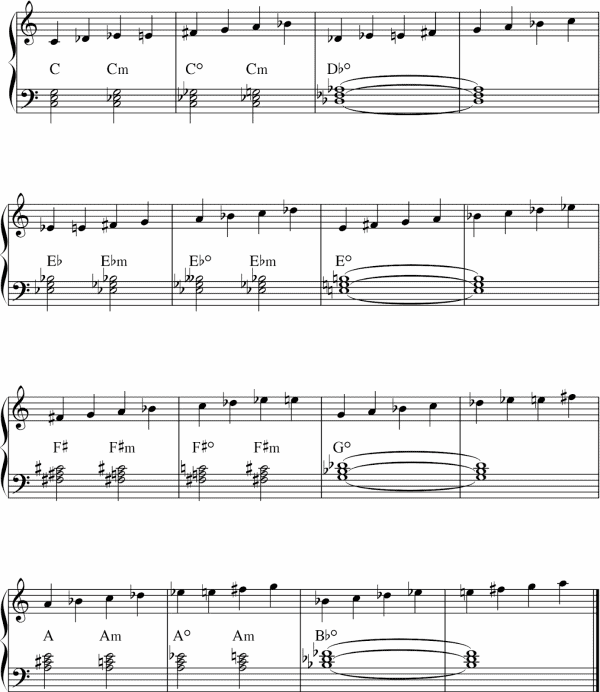The diminished scale, or octatonic scale, is an enigmatic and distinct scale that offers a great deal of melodic and harmonic depth and possibility. There are examples of the diminished scale in European classical music dating back to the time of Bach and also in various folk music traditions from the Middle East. However, the scale became a more established and widely recognized tonal color during the 20th century thanks to composers like Igor Stravinksy, Olivier Messian, Béla Bartók, and Claude Debussy among others.
In this article, we will explore the construction of the diminished scale, learn how to play the scale on piano, and explore some of the scale’s possible harmonies. When you are ready, dive in!

What is the diminished scale?
The diminished scale is an eight-note scale with a symmetrical construction of alternating whole tones and semitones. The diminished scale is also commonly called the octatonic scale since it has eight tones. However, this is a bit of a misnomer because there are actually a total of 42 unique eight-note pitch sets in our 12 note system.
The diminished scale can also be created by the combination of two fully-diminished seventh chords one half step apart. We will explore this more when we dive into the harmonies of the scale.
How to build the diminished scales
There are two main variations on the diminished scale. Let’s start at the beginning with the “half-whole” diminished scale. The “half-whole” diminished scale gets its name from its repeating pattern of half steps and whole steps, or semitones and whole tones.
Let’s build the scale together from middle C on the piano. Count up a half step from C to C♯, a whole step to D♯, a half step to E, a whole step to F♯, a half step to G, a whole step to A, a half step to B♭, and finally a whole step back to C one octave higher than we started. It’s not too crazy, right?
Check it out notated with the piano finger positions below:
Naturally then, we create the second variation by swapping the starting interval. Instead of the alternating half step/whole step pattern, we will create the scale with an alternating whole step/half step pattern. This variation is called the “whole-half” diminished scale.
Let’s build this scale together from middle C. From C, count up a whole step to D, a half step to E♭, a whole step to F, a half step to G♭, a whole step the A♭, a half step to A♮, a whole step to B, and finally a half step back to C one octave higher.
Check out the whole-half diminished scale notated with piano fingerings below:
Diminished scales overview
Let’s take an overview of the possible half-whole and whole-half diminished scales. First, here are the 12 half-whole diminished scales:
C half-whole | C | C# | D# | E | F# | G | A | Bb | C |
C# half-whole | C# | D | E | F | G | Ab | Bb | B | C# |
D half-whole | D | Eb | F | F# | G# | A | B | C | D |
D# half-whole | D# | E | F# | G | A | Bb | C | C# | D# |
E half-whole | E | F | G | Ab | Bb | B | C# | D | E |
F half-whole | F | F# | G# | A | B | C | D | Eb | F |
F# half-whole | F# | G | A | Bb | C | C# | D# | E | F# |
G half-whole | G | Ab | Bb | B | C# | D | E | F | G |
G# half-whole | G# | A | B | C | D | Eb | F | F# | G# |
A half-whole | A | Bb | C | C# | D# | E | F# | G | A |
Bb half-whole | Bb | B | C# | D | E | F | G | Ab | Bb |
B half-whole | B | C | D | Eb | F | F# | G# | A | B |
And here are the 12 whole-half diminished scales:
C whole-half | C | D | Eb | F | Gb | Ab | A | B | C |
C# whole-half | C# | D# | E | F# | G | A | Bb | C | C# |
D whole-half | D | E | F | G | G# | Bb | B | C# | D |
Eb whole-half | Eb | F | F# | G# | A | B | C | D | Eb |
E whole-half | E | F# | G | A | Bb | C | C# | D# | E |
F whole-half | F | G | G# | Bb | B | C# | D | E | F |
F# half-whole | F# | G# | A | B | C | D | Eb | F | F# |
G half-whole | G | A | Bb | C | C# | D# | E | F# | G |
Ab half-whole | Ab | Bb | B | C# | D | E | F | G | Ab |
A half-whole | A | B | C | D | Eb | F | F# | G# | A |
Bb half-whole | Bb | C | C# | D# | E | F# | G | A | Bb |
B half-whole | B | C# | D | E | F | G | G# | A# | B |
Time for some practice
Let’s practice building two diminished scales on the piano. First, let’s check out the B half whole scale. Then, we will check out the D whole half scale. We will use the interval pattern and method from the C diminished scale as a reference point.
The B half-whole diminished scale begins with B, followed by C a half step higher, then a whole step up to D, a half step up to E♭, a whole step up to F, a half step up to G♭, a whole step up to A♭, a half step to A♮, and finally a whole step to end on B.
Check out the piano scale below:
The D whole half diminished scale begins with D, followed by E a whole step above, then a half step up to F, a whole step up to G, a half step up to A♭, a whole step to B♭, a half step to B♮, a whole step to C♯ and finally a half step to finish again on D.
Check it out notated with piano fingerings below:
Diving into diminished scale theory
With its expanded melodic and harmonic palette, the diminished scales have found a home in 20th and 21st century classical music, in film music, in jazz music, and even in rock music. The scale offers many possibilities beyond the simple tonality of the diatonic scale. Let’s explore now some of the harmonic possibilities of the whole-half and half-whole diminished scales.
If you feel like you need some basic overview on scale theory before diving into the depths of the diminished scale, consider studying with one of the best apps for learning piano to build your skills.
Chords of the half-whole diminished scale
If we choose to build triads using the same method that we have explored in other scales like the melodic minor scale, we will quickly run into some perplexing problems. Let’s start again with the C half-whole diminished scale. The C half-whole diminished scale is spelled:
C – D♭ – E♭ – E♮ – F♯ – G – A – B♭ – C
Do you notice anything that might prove problematic here if we build chords in the usual way of stacking thirds? For example, there is both a minor third (E♭) and major third (E) above C. There is both a minor third (G♭) and major third (G) above E♭. There is both a minor third (A) and a major third (A♯) above F♯. And there is both a minor third (C) and a major third (C♯) above A.
Already we can see that there are many more possible chords inside this single diminished scale than in any of the diatonic scales like the harmonic minor scale. Also, notice how each of these notes (C, E♭, G♭, A) are each a minor third apart? This is part of the symmetrical nature of the diminished scales. If you start the half-whole diminished scale from any of these tones, you will place the exact same set of pitches. These scales are like multidimensional fun house musical mirrors.
Below are the possible triads built from each tone of the C half-whole diminished scale:
There are 16 basic triads inside the half-whole diminished scale. Notice how each of the symmetrical pivot points has three triads associated with it (major, minor, and diminished) while each of the passing tones (D♭, E, G, B♭) only have a diminished triad. Notice again that the combination of these passing tones spells the second fully diminished seventh chord (D♭ – F♭ – A♭♭ – C♭♭) that we briefly touched earlier.
Spend some time exploring these triads. They offer a significantly wider range of possibilities than the basic diatonic scale triads.
Chords of the whole-half diminished scale
Now, let’s explore the triads built from the whole-half diminished scale. Remember that the C whole-half diminished scale is spelled:
C – D – E♭ – F – G♭ – A♭ – A♮ – B – C
Notice here that we have the same problem building chords in thirds as we did with the half-whole diminished scale, just the pivot notes are shifted up the scale by one note. For example, there are two possibilities for thirds above D, two possibilities above F, two possibilities above A♭, and two possibilities above B. Again, these pivot notes spell a fully diminished seventh chord, just like they did in the half-whole diminished scale.
Here are the possible triads in the C whole-half diminished scale:
How to use the diminished scales
At this point, you might be wondering how exactly to use these scales. Naturally, this is a perfectly legitimate question. The best thing to do at this point is to practice the finger patterns and the matching chords until you can comfortably access the sounds. After that, you can dive into more advanced applications of the scale.
Master this pattern and then begin to explore how you can manipulate it to your own tastes:
Piecing it all together
The diminished scale is an advanced and intriguing sound. Not everyone finds it pleasant, but it opens the gateway to an entire universe of synthetic and symmetrical scales. Remember there are two main variations on the diminished scale: the half step-whole step scale and the whole step-half step scale. Both scales are built from a repeating series of half steps and whole steps.
There are many chords inherent in the diminished scales – at least 8 diminished chords as well as four major and four minor chords. Additionally beyond that there is an entire realm of seventh chords and extended harmonies to explore. Once you are comfortable with the basics, spend some time diving into these more advanced uses. Follow composers like Stravinksy, Messain, Jonny Greenwood, and others as guides.
Whether you are interested in learning more about music theory concepts like the diminished scales, or just interested in learning some basic songs and having fun with the piano, Skoove is here to help you discover your musical abilities.
Author of this blog post:

Eddie Bond is a multi-instrumentalist performer, composer, and music instructor currently based in Seattle, Washington USA. He has performed extensively in the US, Canada, Argentina, and China, released over 40 albums, and has over a decade experience working with music students of all ages and ability levels.















